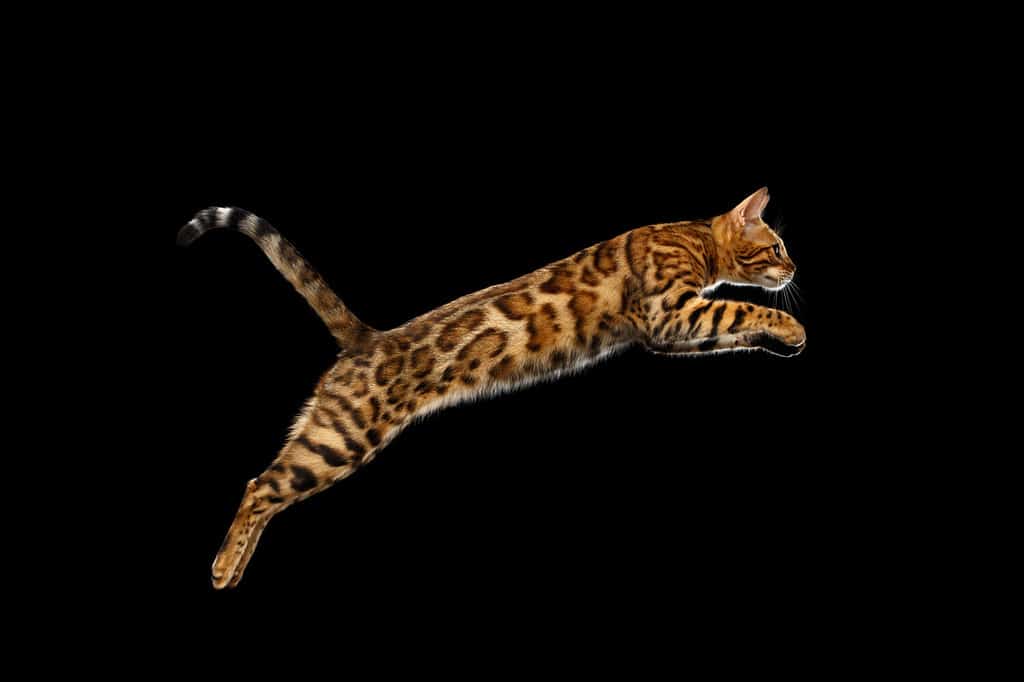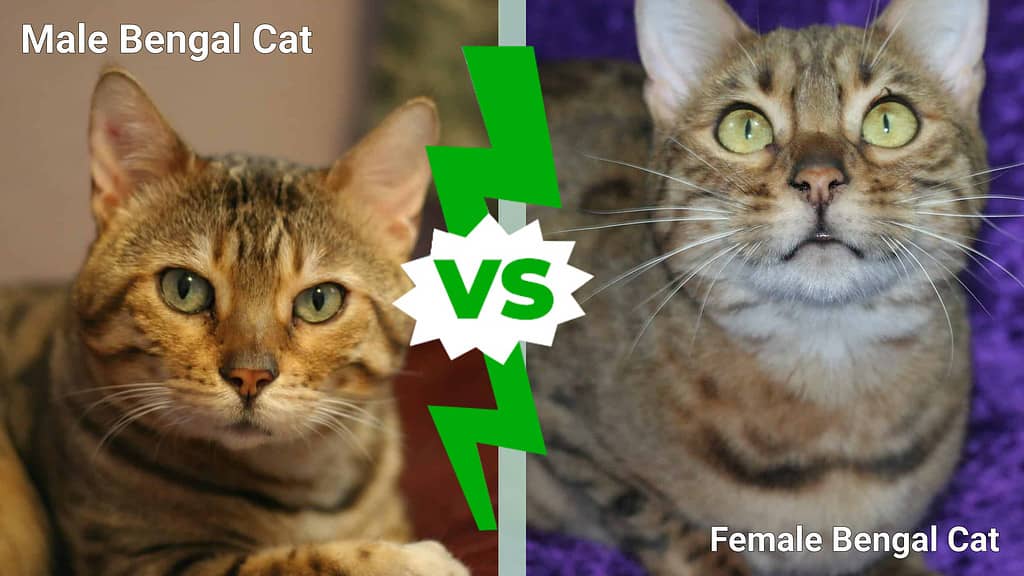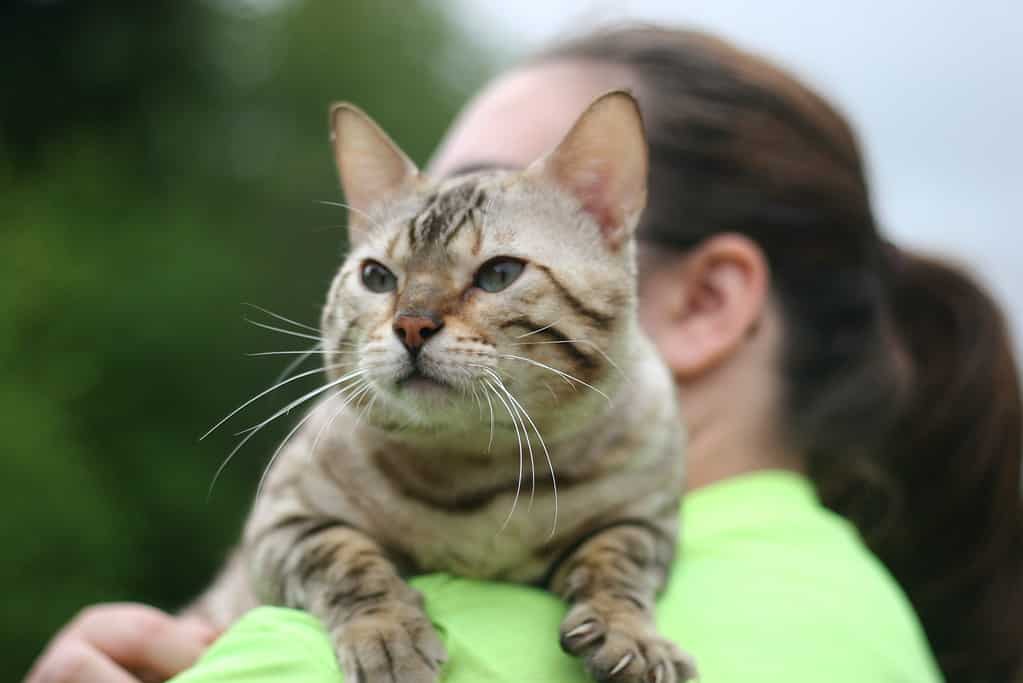When comparing male versus female Bengal cats, there are several differences to consider. Bengal cats are a very popular breed sought by people all over the world. These leopard look-a-likes bring much joy to their owners. Choosing a male versus a female can be a complicated choice. Let’s explore the differences and find out if a male or female Bengal cat is the right one for you!

Bengal cats are beautiful and athletic.
©Seregraff/Shutterstock.com
What is a Bengal Cat?
The Bengal is a purebred cat breed originating in the 1960s in the United States. Breeders created them by crossing the Asian leopard cat with domestic cats. Widely considered hypoallergenic, the Bengal cat is extremely popular around the world. Their wild look and impressive lifespan make them a favorite among cat lovers. Not only that, but their athletic antics give their owners lots to laugh about and enjoy.
A Bengal cat can jump up to 15 feet high! They enjoy playing with all kinds of toys and interacting with their owners. Their high energy and willingness to play are endearing features. Some Bengals even go on adventures like hiking and boating. They come in many colors and two patterns: spotted and marbled. These cats live 12-20 years, and progression from kitten to adult takes only about one year. The rate of maturing depends on several things. Color, gender, and if they are intact ( not neutered/spayed) may affect this. Some Bengals don’t fully mature until about two years old.
Comparing Male vs. Female Bengal Cats
| Key Differences | Male Bengal Cat | Female Bengal Cat |
|---|---|---|
| Size | 10-22 pounds | 6-15 pounds |
| Head Shape | Wide with jowls | More narrow, no jowls |
| Behavior | More affectionate | More independent |
| Territory/Dominance | Can be dominant toward housemates | Less likely to show dominance |
| Vocalization | Tend to vocalize a lot, especially when intact | Generally less vocal |
| Heat Cycle | Never happens | Happens only if intact |
| Fertility | Fertile at 4 months, sexually mature at 10-16 months, F1-G3 infertile, G4 likely be infertile | Fertile at 4 months, sexually mature at 6-8 months, fertile during heat cycle only |
| Health Problems | More prone to HCM and FIC | More prone to pyometra |
Male vs. Female Bengal Cats: Size
Size is one of the most prominent differences between male and female Bengal cats.
Generally, males are much larger and heavier than females. Males can grow up to 22 pounds, while females rarely weigh more than 15 pounds. Additionally, males show a tendency to lean toward a more muscular frame, although all Bengals should exhibit a well-muscled build. At cat shows, judges assign blue cards to males and pink cards to females. When you line them up together, the size difference between males and females is easily noticeable.

Male Bengal cats are larger than females.
©A-Z-Animals.com/Rachael Monson / Nemera Bengals
Male vs. Female Bengal Cats: Head Shape
Another important difference between male and female Bengals is the shape of the head.
Males have wider heads with strong, puffy jowls. Jowls are the jaw muscles. This feature is all related to mating. In the wild, male cats must have strong jowls to have a stronger bite force. This helps them win fights over the right to breed with females. It also helps them hold the female in place during breeding. Unfortunately, cat breeding in all species is not a comfortable experience for the female. That’s why you often see the female turn around and beat up on the male after they have bred.
Neutering a male Bengal before sexual maturity may result in the development of smaller jowls compared to an intact male.

Male vs. Female Bengal Cats: Behavior with Humans
How male and female Bengal cats behave with their human friends is another difference.
Males typically crave more attention and give more affection than females. Females are generally more independent. Most Bengals resist humans picking up or holding them, but some males tolerate and enjoy it. Many Bengal cat owners prefer males due to their tendency towards seeking human attention more frequently. However, all Bengal cats are different, and females can be affectionate too.
The Famous Bengal Bond
Bengals are famous for choosing one person in the family to bond with, their person. The cat will likely follow the person around the home once they bond. Many bonded Bengals wait for their owners near the window or door for them to come home. They will often “make biscuits” in their person’s lap. This action is a reminder of when they were babies, nursing from their mother and kneading her belly. Some people call this kneading action “happy feet” because it means the cat is very content.
Sometimes, the bond between a Bengal and its person is so strong that the cat will not eat when the person is not home. Unfortunately, this can be a problem if the owner must leave for a while. Bengals often experience difficulty adjusting when their owners die and when they go to a new home.

Male Bengals are generally more affectionate than females.
©A-Z-Animals.com/Rachael Monson / Nemera Bengals
Male vs. Female Bengal Cats: Territory and Dominance
This difference between male and female Bengal cats usually pertains only to intact cats.
Because hormones play a huge part in territory and dominance, removing them can prevent these behaviors. Unfortunately, some cats are more dominant regardless of their ability to breed.
In any case, males tend to exhibit more dominance than females. It is a male’s job to protect his territory and seek out females for breeding. Intact males spray their area with urine to let other males know it belongs to them. This behavior is scent marking. Scent marking is common in all species of cats.
While females can also spray, it is uncommon. Females can display dominant behavior toward other females, but they tend to get along better than males with males. Bengal cat breeders often have to keep males separate from their breeding colony due to the danger of fights between males. Neutering does not disable spraying, but it will likely reduce a male’s drive to mark territory.

Intact male cats of all species scent mark their territory,
©sandf320/iStock via Getty Images
Male vs. Female Bengal Cats: Vocalization
Vocalization is another difference between male and female Bengal cats.
Male Bengal cats vocalize more frequently than females, especially if they are intact. However, both males and females “talk” to their owners. This trait is one of the most adorable things about Bengal cats. They often meow, chirp, trill, and purr with their human companions. Many owners learn to tell what certain noises or calls mean!
Intact male Bengals call out for females. This is common in many cat species. Females can be very vocal when they are in heat, as well. Male Bengals tend to be much louder than females since they are larger. Also, in the wild, their voice needs to carry as far as possible to reach potential mates.
Male vs. Female Bengal Cats: Heat Cycles
This difference between male and female Bengal cats is related to reproduction.
Female Bengal cats go through periods where they are ready to mate with a male, called the heat cycle or coming into season. A heat cycle marks the time when the uterus (where babies grow) is ready to accept fertilized eggs. A male will never have a heat cycle because he does not have a uterus.
Female Bengals can have anywhere from one to 10 kittens in a single litter (a group of kittens born together). The average litter is four kittens. Larger litters prove difficult, and some kittens may die.
Heat Cycles and Breeding
Female Bengal cats experience a heat cycle as early as four months old. However, breeding a cat this young is not safe for her or the kittens. Responsible breeders do not breed females until they reach at least one year of age. Males can breed as early as four months old but should wait until they are at least a year old, as well. Breeding a young, inexperienced male to a female can result in a life-threatening infection for the female, called pyometra. We will discuss this in more detail below. Spaying a female will eliminate her heat cycles and the risk of pyometra.
Veterinarians and breeders alike highly recommend neutering/spaying all pet Bengals.

The average Bengal cat litter is four kittens.
©A-Z-Animals.com/Rachael Monson / Nemera Bengals
Male vs. Female Bengal Cats: Fertility
As we discussed above, some Bengals can breed as early as four months old. While male Bengals take 10-16 months to become sexually mature, females take only 6-8 months. Nevertheless, waiting until fully sexually and otherwise mature is more beneficial for both males and females.
Generations in Bengals and the Effect on Fertility
Fertility refers to the ability to reproduce. Earlier, we talked about Bengal origin. Breeders used domestic cats to cross-breed with Asian leopard cats, a small spotted wild cat from Asia, creating the breed known as Bengal cats. This process is hybridization, otherwise defined as the DNA of the two species combining to create something new. Hybridization only occurs when the species’ DNA is close enough to match up.
What Are Generations in Bengals?
In Bengal cats, this first cross is F1. The “f” stands for filial generation. Previously, Bengal cats were classified by their generation with F1, F2, F3, etc. However, Bengal breeders recently have been transitioning to using “g” for generation instead. This change aims to aid the public in accepting Bengals as domesticated cats. At present, first-generation crosses alone use “f”, whereas the following generations use G2, G3, and beyond. Studbook Traditional (SBT) refers to Bengals reaching G5 and beyond. The terms early-generation or foundation refers to Bengals F1-G4.
How Does Generation Affect Fertility?
Early-generation male Bengals (F1-G3) are always sterile, meaning they cannot reproduce at all. This is a direct result of poor hybridization. No one knows, for sure, why this only affects males. Most G4 male Bengals are also sterile. By G5, the males can breed. For this reason, breeders almost always neuter F1-G4 Bengal males to prevent spraying and then sell them as pets.

Breeders neuter early-generation male Bengal cats and sell them as pets.
©A-Z-Animals.com/Rachael Monson / Nemera Bengals
Male vs. Female Bengal Cats: Health Problems
Bengal cats are prone to several health concerns. Researching these and finding a breeder that actively tests for diseases is key to finding the perfect Bengal cat for your family. This is not an extensive list. Always research any breed you’re considering for adoption to prepare yourself for possible health problems. Taking your Bengal cat in for regular veterinary visits can help eliminate health concerns.
Hypertrophic Cardiomyopathy (HCM)
HCM is a heart condition that causes the inner wall of the heart to become thickened over time. This leads to the heart becoming enlarged to compensate for the lack of room for blood to flow. Eventually, it leads to heart failure and death. This disease is more common in male versus female Bengal cats. At the time of writing, nobody knows why males are affected more often.
Feline Idiopathic Cystitis (FIC)
FIC is a disease of the urinary tract. It is characterized by inflammation of the bladder and urethra that can lead to a urinary blockage (inability to urinate/pee). The urethra is a tube-like structure that passes urine from the bladder to the outside of the body.
A urinary blockage is an absolute emergency. If the blockage cannot be removed, the bladder can rupture, and the cat will die. Males are more likely to suffer from this condition because their urethra is more narrow than a female’s. This condition can also be complicated by crystalluria or the formation of tiny crystals inside the bladder. These crystals can pass through the urethra, causing pain and inflammation. Sometimes, the crystals are large enough to cause a blockage themselves.
FIC is one diagnosis in a group of diseases under the Feline Lower Urinary Tract Disease (FLUTD) umbrella.
Pyometra
Pyometra is a life-threatening infection that forms inside the female Bengal’s uterus. This condition only affects intact females. The infection is usually caused by E. coli bacteria. This bacterium becomes implanted into the uterus, either by a poorly aimed male trying to breed or the female cleaning her back end. The condition can be classified as open or closed.
Open pyometra means that the uterus has not closed itself off, and the infection can leak out of the birth canal. Closed pyometra is much more deadly because the infection cannot leak out and continues to build inside the body. If the uterus ruptures, the infection will spread into the body cavity and surrounding tissues, resulting in sepsis. Sepsis is widespread inflammation throughout the body caused by the bloodstream’s response to an infection. A rupture pyometra is nearly always deadly.
Typically, spaying the cat as soon as symptoms arise cures this condition. Males cannot contract pyometra because they do not have a uterus. Neutering males prevents spraying, aggression, and prostate cancer.

Keeping your Bengal cat healthy is essential by providing regular check-ups and vaccinations.
©Pressmaster/Shutterstock.com
Male vs. Female Bengal Cats: How to Choose
We’ve learned all about the differences between male and female Bengal cats. Choosing which one you want is a very personal choice. Do your research. Visit the breeder and meet the kittens!
If you are looking for a companion that bonds closely with you and loves to play, you can’t go wrong with either a male or a female. Prefer a cat that wants to be in your lap and give you affection often? Then pick a male. Want a cat that is a little more independent and less likely to have health problems? Go with a female. No matter which you choose, prepare for your new family member to live for at least 12 years.
The photo featured at the top of this post is ©
Thank you for reading! Have some feedback for us? Contact the AZ Animals editorial team.






